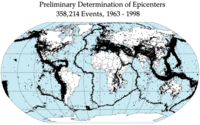
Photo from wikipedia
The impacts of seismic loadings to fault zone rocks are still not well understood. While field and experimental studies have suggested several markers, such as pseudotachylytes and pulverized rocks, for… Click to show full abstract
The impacts of seismic loadings to fault zone rocks are still not well understood. While field and experimental studies have suggested several markers, such as pseudotachylytes and pulverized rocks, for indicating seismic loadings, the corresponding markers of other types or at larger scales are still lacking. Here by summarizing results of dynamic ruptures with off-fault damage, we recognize several additional fracture features that may be used to reflect the involvement of seismic loadings. For strike-slip faults stressed at moderate to high angles, synthetic R shear is more favored during rupture propagation, but pronounced antithetic R’ shear can be generated around the termination end of the rupture. In addition, suitably oriented weak structures off the main fault can further facilitate the activation of R’ shear. For low-angle thrust faults such as subduction zones, splay faults in the form of forethrusts and backthrusts can still be generated above the coseismic rupture zone. These faults show an increased spatial extent towards the updip direction, effectively defining an outer wedge susceptible to pervasive compressional failure over its entire depth range. Moreover, a deeply nucleated megathrust rupture that eventually reaches the trench can sequentially load the frontal wedge in compression and then in extension, with a potential to leave a mixture of triggered reverse and normal faults at the final stage. Because the above results are also supported by many observations, they raise a caution that existing fault models ignoring dynamic effects should be used with care, and that seismic loadings must be considered more seriously by future fault zone studies.
Journal Title: Interpretation
Year Published: 2020
Link to full text (if available)
Share on Social Media: Sign Up to like & get
recommendations!